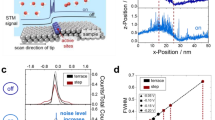Abstract
A silicon carbide-supported silver catalyst used in the oxydehydrogenation of ethylene glycol to glyoxal has been studied by scanning tunneling microscopy. The surface morphology depends upon reaction conditions. Silver particles normally sinter into large plates covering the support. However, in the presence of diethylphosphite there is a chemical erosion which results in a tortuous and fractal-like surface.
Similar content being viewed by others
References
G. Binnig and H. Rohrer, Rev. Mod. Phys. 59 (1987) 615.
P.K. Hansma and J. Tersoff, J. Appl. Phys. 61 (1987) R1-R23.
D.R. Denley, Ultramicroscopy 33 (1990) 83.
Author information
Authors and Affiliations
Rights and permissions
About this article
Cite this article
Gallezot, P., Tretjak, S., Christidis, Y. et al. Characterization by scanning tunneling microscopy of silver oxydehydrogenation catalysts. Catal Lett 13, 305–312 (1992). https://doi.org/10.1007/BF00765032
Received:
Accepted:
Issue Date:
DOI: https://doi.org/10.1007/BF00765032



